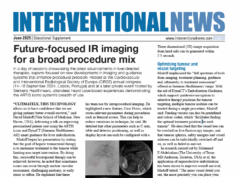 The Cardiovascular and Interventional Radiological Society of Europe (CIRSE) 2023 annual meeting (9–13 September, Copenhagen, Denmark) saw presenters explore where thyroid thermal ablation treatments sit within practice today and how guideline recommendations worldwide have shifted to encompass the treatment option for patients today.
The Cardiovascular and Interventional Radiological Society of Europe (CIRSE) 2023 annual meeting (9–13 September, Copenhagen, Denmark) saw presenters explore where thyroid thermal ablation treatments sit within practice today and how guideline recommendations worldwide have shifted to encompass the treatment option for patients today.
Consistent “near-zero” complication rates with thermal ablation techniques
Teresa Dionisio (Centro Hospitalar Vila Nova de Gaia/Espinho, Vila Nova de Gaia, Portugal) began her presentation by setting out contemporary techniques for thyroid thermal ablation, expositing radiofrequency, microwave and laser ablation as the three “most applied” methods used today. After brief description of each technique, Dionisio poses her central question: “What do we know about these different techniques?”
In past guidelines such as the American Association of Clinical Endochronologists’ (AACE) Dionisio explains, microwave ablation has often been placed as a secondary treatment option due to the “higher risks of minor and major complications”. “At that time we only had access to 40–60 gauge needles, so it was like killing a fly with a canon—it worked but caused a lot of collateral damage”.
Recent guidelines however have stated that laser, radiofrequency and microwave are “similarly safe and effective”, Dionisio said, broadening treatment options for patients dependant on “individual competencies and the research of the hospital”. Adding to this, she shares that overall complication rates for these ablation techniques are less than 4%, major complications less than 1% and there have been no life threatening complications reported to date.
Concluding Dionisio stated: “Thyroid ablation is a very safe procedure, if you plan for these events and understand the neck anatomy well, you can keep the complication rate near to zero”.
“Optimum” characteristics presented for successful thermal ablation of benign lesions
“Patient selection is of central importance,” Bulent Cekic (Antalya Education and Research Hospital, Antalya, Turkey) underlined, placing this among his key messages when describing the current indications and contraindications for thermal ablation of benign thyroid lesions during his presentation at CIRSE 2023.
“We do not ablate every nodule” when considering the best candidates for thermal ablation Cekic explained, nodule features such as spongiform echostructure, nodules with a liquid component, and soft nodules, are all elements that crucially increase volume reduction rate (VRR).
Continuing, Cekic conveyed his approach to treating toxic adenomas below 10ml in volume, noting the primary factor which affects the success of thermal ablation in these cases is the volume of the adenoma before treatment. Supporting this, Cekic references a study conducted by Roberto Cesareo (Santa Maria Goretti Hospital, Latina, Italy) et al, who divided their toxic adenoma group into two—those with a volume of more than 12ml and less than 12ml. Their results showed that, in the smaller volume group, euthyroidism via thermal ablation was achieved in 86% of patients, compared to 45% in the large volume group.
Supported by this research, Cekic’s clinic have found a “solution” that informs “ongoing clinical training” which stipulates, for adenomas below 10ml, thermal ablation is performed initially, followed by an injection of 4–5 cubic centimetres (cc) of 90% ethanol. By using this technique Cekic tells the audience, they “always have a 95% VRR” with a recurrence rate of adenomas of 1–2%.
Cekic adds that “careful anatomical assessment should always be performed before the procedure”, reiterating that clinicians must understand and apply their “[knowledge of] managing potential complications following the procedure” to have the best results.
Thermal ablation for malignant thyroid lesions has “come of age” worldwide
Closing out the session, Myrsini Gkeli (Agios Savvas General Anticancer Oncological Hospital, Athens, Greece) describes how “thermal ablation for malignant thyroid lesions as come of age around the world”, however “optimal” ablation techniques and “proper indications” remain as “challenges” for the future.
First, Gkeli cast an eye over global radiofrequency ablation (RFA) guidelines for the treatment of recurrent thyroid cancers in years past. Reaching 2022, he outlined an international multidisciplinary consensus statement which recommended RFA for the treatment of both benign and malignant thyroid disease.
Displaying a range of meta-analyses and long-term studies which have investigated the safety and effectiveness of RFA for these patients, the speaker relayed how these data demonstrate “significant tumour volume reduction” at six months, seven and nine years follow-up, respectively.
“The use of thermal ablation may be considered as an alternative option to active surveillance in incidentally discovered low-risk papillary thyroid microcarcinoma patients who are not eligible for surgery,” Gkeli told CIRSE delegates.










